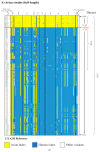Avian Influenza H7N9 Virus Adaptation to Human Hosts
- PMID: 34068495
- PMCID: PMC8150935
- DOI: 10.3390/v13050871
Avian Influenza H7N9 Virus Adaptation to Human Hosts
Abstract
Avian influenza virus A (H7N9), after circulating in avian hosts for decades, was identified as a human pathogen in 2013. Herein, amino acid substitutions possibly essential for human adaptation were identified by comparing the 4706 aligned overlapping nonamer position sequences (1-9, 2-10, etc.) of the reported 2014 and 2017 avian and human H7N9 datasets. The initial set of virus sequences (as of year 2014) exhibited a total of 109 avian-to-human (A2H) signature amino acid substitutions. Each represented the most prevalent substitution at a given avian virus nonamer position that was selectively adapted as the corresponding index (most prevalent sequence) of the human viruses. The majority of these avian substitutions were long-standing in the evolution of H7N9, and only 17 were first detected in 2013 as possibly essential for the initial human adaptation. Strikingly, continued evolution of the avian H7N9 virus has resulted in avian and human protein sequences that are almost identical. This rapid and continued adaptation of the avian H7N9 virus to the human host, with near identity of the avian and human viruses, is associated with increased human infection and a predicted greater risk of human-to-human transmission.
Keywords: H7N9; adaptation; avian viruses; diversity; host; human viruses; influenza virus; motifs; surveillance; zoonosis.
Conflict of interest statement
We declare that we have no competing interests in this research.
Figures






Similar articles
-
Emergence and Adaptation of a Novel Highly Pathogenic H7N9 Influenza Virus in Birds and Humans from a 2013 Human-Infecting Low-Pathogenic Ancestor.J Virol. 2018 Jan 2;92(2):e00921-17. doi: 10.1128/JVI.00921-17. Print 2018 Jan 15. J Virol. 2018. PMID: 29070694 Free PMC article.
-
Rapid adaptation of avian H7N9 virus in pigs.Virology. 2014 Mar;452-453:231-6. doi: 10.1016/j.virol.2014.01.016. Epub 2014 Feb 14. Virology. 2014. PMID: 24606700
-
Environmental connections of novel avian-origin H7N9 influenza virus infection and virus adaptation to the human.Sci China Life Sci. 2013 Jun;56(6):485-92. doi: 10.1007/s11427-013-4491-3. Epub 2013 May 8. Sci China Life Sci. 2013. PMID: 23657795
-
Genetic tuning of avian influenza A (H7N9) virus promotes viral fitness within different species.Microbes Infect. 2015 Feb;17(2):118-22. doi: 10.1016/j.micinf.2014.11.010. Epub 2014 Dec 11. Microbes Infect. 2015. PMID: 25498867 Review.
-
Enabling the 'host jump': structural determinants of receptor-binding specificity in influenza A viruses.Nat Rev Microbiol. 2014 Dec;12(12):822-31. doi: 10.1038/nrmicro3362. Epub 2014 Nov 10. Nat Rev Microbiol. 2014. PMID: 25383601 Review.
Cited by
-
An Alignment-Independent Approach for the Study of Viral Sequence Diversity at Any Given Rank of Taxonomy Lineage.Biology (Basel). 2021 Aug 31;10(9):853. doi: 10.3390/biology10090853. Biology (Basel). 2021. PMID: 34571730 Free PMC article.
References
Publication types
MeSH terms
Substances
LinkOut - more resources
Full Text Sources
Medical

